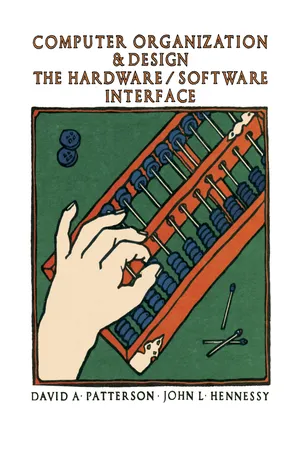
Computer Organization and Design
The Hardware / Software Interface
- 876 pages
- English
- PDF
- Available on iOS & Android
Computer Organization and Design
The Hardware / Software Interface
About this book
Computer Organization and Design: The Hardware/Software Interface presents the interaction between hardware and software at a variety of levels, which offers a framework for understanding the fundamentals of computing. This book focuses on the concepts that are the basis for computers. Organized into nine chapters, this book begins with an overview of the computer revolution. This text then explains the concepts and algorithms used in modern computer arithmetic. Other chapters consider the abstractions and concepts in memory hierarchies by starting with the simplest possible cache. This book discusses as well the complete data path and control for a processor. The final chapter deals with the exploitation of parallel machines. This book is a valuable resource for students in computer science and engineering. Readers with backgrounds in assembly language and logic design who want to learn how to design a computer or understand how a system works will also find this book useful.
Frequently asked questions
- Essential is ideal for learners and professionals who enjoy exploring a wide range of subjects. Access the Essential Library with 800,000+ trusted titles and best-sellers across business, personal growth, and the humanities. Includes unlimited reading time and Standard Read Aloud voice.
- Complete: Perfect for advanced learners and researchers needing full, unrestricted access. Unlock 1.4M+ books across hundreds of subjects, including academic and specialized titles. The Complete Plan also includes advanced features like Premium Read Aloud and Research Assistant.
Please note we cannot support devices running on iOS 13 and Android 7 or earlier. Learn more about using the app.
Information
Table of contents
- Front Cover
- Computer Organization and Design: The Hardware/Software Interface
- Copyright Page
- Table of Contents
- Dedication
- Foreword
- Preface
- The SPIM Simulator for the MIPS R2000/R3000
- Chapter 1. Computer Abstractions and Technology
- Chapter 2. The Role of Performance
- Chapter 3. Instructions: Language of the Machine
- Chapter 4. Arithmetic for Computers
- Chapter 5. The Processor: Datapath and Control
- Chapter 6. Enhancing Performance with Pipelining
- Chapter 7. Large and Fast: Exploiting Memory Hierarchy
- Chapter 8. Interfacing Processors and Peripherals
- Chapter 9. Parallel Processors
- A. Assemblers, Linkers, and the SPIM Simulator
- B. The Basics of Logic Design
- C. Mapping Control to Hardware
- D. Introducing C to Pascal Programmers
- E. Another Approach to Instruction Set Architecture—VAX
- Index